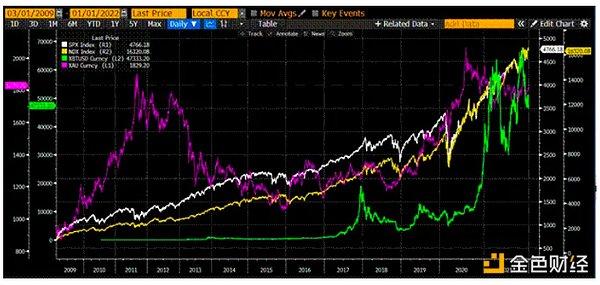Asset Collapse: Global Markets Plunge into Chaos
Global financial markets are experiencing their darkest moment, with a storm triggered by U.S. President Donald Trump's new tariff policies sweeping across major asset classes. On Monday's opening, U.S. stock futures looked bleak, with S&P 500 futures dropping 3.2%, Nasdaq 100 futures plummeting 5.7%, and VIX futures surging 34.4% to 45.8, reaching the highest level since 2022. Safe-haven sentiment pushed 10-year U.S. Treasury prices higher, with the yen appreciating 1.3% against the dollar, and spot gold falling to $2,988.61 per ounce.
Last Thursday, the S&P 500 plunged 4.8%, closing at 4,850 points, marking the largest single-day drop in 2024. On Friday, the selling wave continued, with the Dow Jones Industrial Average tumbling 2,231 points, a 5.5% drop, closing at 38,900 points, erasing nearly two months of gains. The Nasdaq Composite, dominated by tech stocks, fell a cumulative 11.8% over two days, officially entering bear market territory. Tech giants performed poorly: Apple dropped to $205, down 5.5%; Tesla briefly fell 10.3%, closing at $310; NVIDIA's market value evaporated by over $300 billion, dropping 9.1%. Global stocks were simultaneously under pressure, with Japan's Nikkei 225 opening down 5.6% and temporarily halting trading for 15 minutes after hitting the 7% circuit breaker; Korea's KOSPI index fell 4.9% to a six-month low; Europe's STOXX 600 index opened down 3.8%.
Commodities markets were not spared. Gold broke below the $3,000 per ounce psychological level, touching a low of $2,988.61, down 1.9%, while silver fell 2.3% to $34.50 per ounce. The energy market was severely hit, with WTI crude futures dropping to $59.80 per barrel, down 12% from last week's high, reaching a new low since April 2021; Brent crude fell to $63.20 per barrel. Industrial metal prices declined, with New York copper futures dropping 8.2% to $3.85 per pound, reflecting market pessimism about global manufacturing. Foreign exchange markets became more volatile, with the Australian dollar falling 1.1% to 0.6350, the euro dropping 0.9% to 1.0450, and the U.S. dollar index rising to 104.50, a three-month high.
The cryptocurrency market could not escape the fate of risk assets. CoinMarketCap data shows the global crypto market cap shrinking from $2.4 trillion to $2.16 trillion, a 10% drop. Bit dropped 6%, touching a low of $77,100; Ethereum fell 12.4% to $1,540; the crypto market's performance highly synchronized with Nasdaq, highlighting its "high-beta asset" characteristics. Total liquidations in the past 24 hours amounted to $886 million.

Bond market concerns were also escalating. The MOVE Index (Merrill Lynch Option Volatility Estimate Index), a measure of U.S. Treasury implied volatility, surged from 108.50 in late March to 125.71, a 15.8% increase. BitMEX founder Arthur Hayes noted: "To predict when the Federal Reserve will capitulate and ease significantly, the MOVE Index is a key indicator. The higher the index, the higher the margin requirements for Treasury and corporate bond trading, and selling pressure will sweep the market. This is the Federal Reserve's last stand. If it breaks 140, easing will be inevitable." The current level is just a step away from the critical point, suggesting greater turbulence is imminent.

Trump's Poker Face and Market Confrontation
... (rest of the text continues in the same manner)Safe-haven assets become a rare bright spot. The 10-year US Treasury yield fell 10 basis points to 3.89%, and the 2-year yield dropped 19 basis points to 3.46%. Bloomberg data shows that the global negative-yield bond scale rose to $16.5 trillion, reaching a 2023 high. The Japanese yen rose to 148.50 against the US dollar, and the Swiss franc increased by 0.8%. Although gold has a short-term pullback, it remains attractive in the long term, with UBS predicting it may return to $3,100 per ounce by year-end.
The Federal Reserve's Tipping Point: The MOVE Index's Warning
The Federal Reserve is facing unprecedented pressure. Tariffs may drive up import costs, with inflation concerns emerging - Goldman Sachs estimates that if 34% tariffs are implemented, US CPI could rise by 1.2 percentage points within 12 months. However, market crashes and bond volatility are forcing easing. Hayes' MOVE index theory becomes the focus: "When the MOVE index rises, the financing costs of Treasury trading surge, and selling pressure will be transmitted to the financial system. The Federal Reserve has no choice but to act. 140 is the tipping point." The current index is at 125.71, and if panic intensifies on Monday, it may quickly break through.
There are internal disagreements at the Federal Reserve. Hawkish officials advocate waiting for inflation data, while doves warn that delays could cause systemic risks. Chicago Fed President Evans states: "When markets are disorderly, monetary policy must be decisive." The market expects the May FOMC meeting might initiate rate cuts, potentially by 50 basis points.
Where is the Turning Point: A Glimmer After the Massive Shock
Hedge fund manager Bill Ackman offers another possibility: "If Trump announces a tariff delay on Monday to create negotiation space, the market might catch its breath." But he also warns that if policies remain tough, the S&P 500 could drop another 10%, and the economic recession risk could rise from the current 35% to 60%. Ackman concludes: "Regardless, this Monday will determine the direction for the coming months."
Although this shock is terrifying, it may breed an opportunity. After the 2020 meltdown, the Federal Reserve's decisive intervention reversed the downturn; now, the MOVE index's warning is sounding, and the pressure for rate cuts is increasing daily. If the Federal Reserve yields, loose policies might inject vitality into the market and reignite investor confidence. History tells us that the deepest darkness often accompanies a glimmer of light. Trump's tough stance and the market's fragility are in a tug-of-war, with the Federal Reserve's choice becoming the decisive variable.
The call for rate cuts is growing louder - perhaps the first ray of sunshine after the storm. For investors, gold's pullback is a buying opportunity, and tech stocks' collapse is a touchstone testing patience. As Ackman says, this Monday will be recorded in history, and the Federal Reserve's actions may unexpectedly conclude this crisis.






